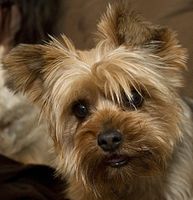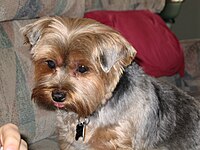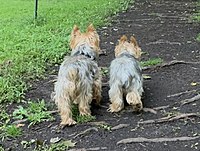Yorkshire Terrier
| Yorkshire Terrier | |||||||||||||
|---|---|---|---|---|---|---|---|---|---|---|---|---|---|
 | |||||||||||||
| Origin | Yorkshire, England | ||||||||||||
| |||||||||||||
| |||||||||||||
| Dog ( domestic dog ) | |||||||||||||
The Yorkshire Terrier, also known as a Yorkie, is a British
It is a playful and energetic dog, usually kept as a
History


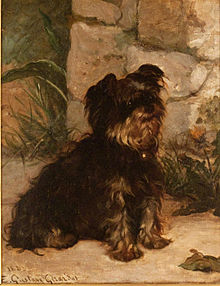
The Yorkshire Terrier originated in Yorkshire. In the mid-nineteenth century, workers from Scotland came to Yorkshire in search of work and brought with them several varieties of terrier dogs. Breeding of the Yorkshire terrier was "principally accomplished by the people – mostly operatives in cotton and woollen mills – in the counties of Yorkshire and Lancashire."[4] In the 1800s, miners wanting to develop a ratting terrier, bred Black-and-Tan Terriers with the Paisley and Clydesdale Terriers.[5]
Details are scarce. Mrs A. Foster is quoted as saying in 1886,[6]
If we consider that the mill operatives who originated the breed were nearly all ignorant men, unaccustomed to imparting information for public use, we may see some reason why reliable facts have not been easily attained.
The breed originates from two distinct dogs, a male named Old Crab, a female named Kitty, and another female whose name is not known.[7] The Paisley Terrier, a smaller version of the Skye Terrier that was bred for a beautiful long silky coat, also figured into the early dogs. Some authorities believed that the Maltese was used as well.[8] "They were all originally bred from Scotch Terriers (meaning dogs from Scotland, not today's Scottish Terrier) and shown as such the name Yorkshire Terrier was given to them on account of their being improved so much in Yorkshire."[6]
Yorkshire Terriers were shown in a dog show category (class) at the time called "Rough and Broken-coated, Broken-haired Scotch and Yorkshire Terriers". Hugh Dalziel, writing in 1878, says that "the classification of these dogs at shows and in the Kennel Club Stud Book is confusing and absurd" in lumping together these different types.[9] In the early days of the breed, "almost anything in the shape of a Terrier having a long coat with blue on the body and fawn or silver coloured head and legs, with tail docked and ears trimmed, was received and admired as a Yorkshire Terrier".[4] But in the late 1860s, a popular Paisley-type Yorkshire Terrier show dog named Huddersfield Ben, owned by a woman living in Yorkshire, Mary Ann Foster, was seen at dog shows throughout Great Britain, and defined the breed type for the Yorkshire Terrier.[10]
Huddersfield Ben
Huddersfield Ben was a Yorkshire Terrier whose portrait was painted by
In North America
The Yorkshire Terrier was introduced in North America in 1872
Coat
For adult Yorkshire Terriers, The American Kennel Club places importance on coat colour, quality, and texture.[18] According to The Kennel Club (UK), the hair must be glossy, fine, straight, and silky. Traditionally the coat is grown out very long and is parted down the middle of the back, but "must never impede movement.".[19] The hair of the Yorkshire Terrier can be used to determine content of metals in the dog organism.[20]
From the back of the neck to the base of the tail, the coat should be a dark grey to a black colour,[18] and the hair on the tail should be a darker black.[19] On the head, high chest and legs, the hair should be a bright, rich tan, darker at the roots than in the middle, that shades into a lighter tan at the tips, but not for all dogs. Also, in adult dogs there should be no black hairs intermingled with any of the tan-coloured fur.[18] The fine, straight, silky coat is considered hypoallergenic.
-
A silver-blue and pale cream Yorkshire Terrier, with characteristic long hair
-
A silver-blue and pale cream Yorkshire Terrier.
-
A Yorkshire Terrier with a dark coat
-
Golden Yorkie, judged as miscolour in normal Yorkshire breeding. The saddle is missing due to therecessive gene for red on the extension locus (see Dog coat genetics).
Adult Yorkshire Terriers whose coat colours deviate from the standard, or that have woolly or extra fine coats, are still Yorkshire Terriers. The only difference is that it is not recommended to intentionally breed atypical Yorkshire Terriers.[21] In addition, care may be more difficult for "woolly" or "cottony" textured coats, or coats that are overly fine.[18] Coats may vary in colour. For example, a mature Yorkie may have a silver-blue with light brown, while another might have a black and creamy colour.
The long coat on the Yorkshire Terrier requires regular brushing.[2]
Hypoallergenic coats
The typical fine, straight, and silky Yorkshire Terrier
Other colours
The Yorkshire Terrier is a tan dog with a blue saddle. Particolours exist, although they are not correct for the breed standard. The particolour coat is white with black-blue and tan. The white is caused by the
Mismatched Yorkshire Terriers should not be crossed with the Biewer Terrier, a new breed that originated in Germany.[29] Although the AKC will not deny registration of a Yorkshire Terrier on colour alone, meaning that particolours are now registerable with the AKC, the Yorkshire Terrier Club of America has a directive that "any solid colour or combination of colours other than black and tan" for adult dogs is a disqualification, and "dogs of solid colour, unusual combination of colours, and particolours should be disqualified."[30]
Puppy coats

It may take three or more years for the coat to reach its final colour. The final colour is usually a black or greyish colour.[30] P. H. Combs, writing in 1891, complained about show wins awarded to puppies, when the dog's coat does not fully come in until three or four years old, "and the honour of winning such a prize (for a puppy) can therefore be of but little practical benefit to the owner" since the adult dog's colour cannot be exactly predicted.[31][32]
Coat care

Owners may trim the hair short for easier care. For shows, the coat is left long, and may be trimmed to floor length to give ease of movement and a neater appearance. Hair on the feet and the tips of ears can also be trimmed.[18][19] The traditional long coat is extremely high maintenance. The coat might get knotted if not brushed daily (a bristle brush for short and shaved coat and a pin brush for long coat). In order to prevent breakage, the coat may be wrapped in rice paper, tissue paper or plastic, after a light oiling with a coat oil. The oil has to be washed out once a month and the wraps must be fixed periodically during the week to prevent them from sliding down and breaking the hair. Elaborate coat care dates from the earliest days of the breed. In 1878, John Walsh described similar preparations: the coat is "well greased" with coconut oil, the dog is bathed weekly, and the dog's feet are "carefully kept in stockings".[33]
Temperament

The ideal Yorkshire Terrier character or "personality" has been described by the Kennel Club as having a "carriage very upright conveying an important air".[19]
Yorkshire Terriers are ranked 34th in Stanley Coren's The Intelligence of Dogs.[34]
Health
Health issues often seen in the Yorkshire Terrier include
The Yorkshire Terrier has an above average life expectancy. A study in the UK of patient records found the breed to have a life expectancy of 13 years, higher than the average.
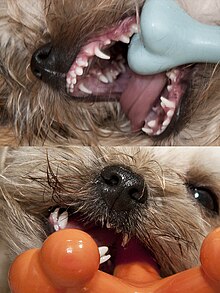

Genetic defects
Certain
The following are among the most common congenital defects that affect Yorkies:- Distichiae, eyelashes arising from an abnormal spot (usually the duct of the meibomian gland at the edge of the eyelid), are often found in Yorkies.[42] Distichiae can irritate the eye and cause tearing, squinting, inflammation, corneal abrasions or corneal ulcers, and scarring. Treatment options may include manual removal, electrolysis, or surgery.[43]
- quadriplegia.[44]
- degenerate, occurs in Yorkies in certain lines.[45] The condition appears to result from insufficient circulation to the area around the hip joint. As the blood supply is reduced, the bone in the head of the femur collapses and dies and the cartilage coating around it becomes cracked and deformed.[45] Usually the disease appears when the Yorkie is young (between five and eight months of age); signs are pain, limping or lameness.[46] The standard treatment is surgery to remove the affected part of the bone.[46] Following surgery, muscles hold the femur in place and fibrous tissue forms in the area of removal to prevent bone rubbing on bone.[47] Although the affected leg will be slightly shorter than prior to surgery, the Yorkie may regain almost normal use.[46]
- Luxating patellas (slipping kneecaps) are another common defect considered to be genetic in Yorkies, although it may also be caused by an accidental fall. Weak ligaments and tendons in the knee or malformed (too shallow) patellar grooves, allow the patella to slip out of its groove sideways.[48] This causes the leg to 'lock up' with the foot held off the ground.[48] A dog with this problem may experience frequent pain and lameness, or may be bothered by it only on occasion. Over time, the patellar ridges can become worn down, making the groove even more shallow and causing the dog to become increasingly lame.[48] Surgery is the main treatment option available for luxating patellas, although it is not necessary for every dog with the condition. The severity of luxating patellas are on a scale of 1 to 4, with 4 being the most severe. Many dogs will not develop past a stage 1 or 2.
- blindness, which could lead to a coma and death. Often, the shunt can be treated with surgery.[49]

- cough suppressants and bronchodilators.[50] If the collapse is advanced and unresponsive to medication, sometimes surgery can repair the trachea.[50]
Hypoglycaemia
Docking and Cropping
Traditionally, the Yorkshire Terrier's tail is docked to a medium length.[57] Opposition to this practice began very early in the history of the breed; Hugh Dalziel, writing about Yorkshire Terriers in 1878, declared that "There is no reason for mutilating pet dogs, and perfect ears and tails should be bred, not clipped into shape with scissors."[9] AKC and Canadian Kennel Club still require the Yorkie's tail be docked in order to compete at its events.[18] The majority of the rest of the world has adopted a "no docking/no cropping" rule.[citation needed]
-
A Yorkshire Terrier, trimmed
-
A Yorkshire Terrier in need of brushing
-
A Yorkshire Terrier with a dark coat
-
A Yorkshire Terrier with floppy uncropped ears
-
According to the standard, the ears must be small, V-shaped, carried erect and set not too far apart. If this is not the case, the dog should not be used for breeding
-
Two Yorkshire Terriers with short hair from the back
Related breeds and derived breeds
The Yorkshire Terrier breed descends from larger but similar Scottish breeds, such as the
The Biewer Terrier, bred from blue, white and gold puppies named Schneeflocke and Schneeflöckchen von Friedheck,[58][59][60] owned by Mr. and Mrs. Biewer in Germany,[61] was once considered a variation of the Yorkshire Terrier but has since been recognised as a separate breed by many kennel clubs, including the AKC.[62]
Notable Yorkshire Terriers
Show dogs
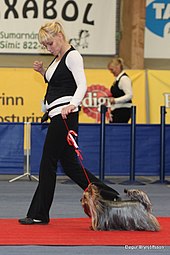
- In 1997, Champion Ozmilion Mystification became the first Yorkie to win Best in Show at Crufts, the world's largest annual dog show.[63][64]
Small dogs
- Sylvia, a matchbox-sized Yorkshire Terrier owned by Arthur Marples of Blackburn, England, was the smallest dog in recorded history. The dog died in 1945 when she was two years old, at which point she stood 2+1⁄2 in (6.4 cm) tall at the shoulder, measured 3+1⁄2 in (8.9 cm) from nose tip to tail, and weighed 4 oz (110 g).[65][66]
War dogs
- Smoky, a war dog and hero of World War II, was owned by William Wynne of Cleveland, Ohio. Wynne adopted Smoky while he was serving with the 5th Air Force in the Pacific.[67]
White House dogs
- Pasha, Tricia Nixon Cox's pet Yorkie, lived in the White House during Richard Nixon's presidency.[68]
Notes
- 1.^ The Japanese study reviewed cemetery data which is unlikely to have any records of still-births and altricial deaths whilst a veterinary clinic likely would have data on these.
References
- ^ a b Yorkshire Terrier. The Kennel Club. Accessed January 2023.
- ^ a b c d "Get to Know the Yorkshire", 'The American Kennel Club', retrieved 19 May 2014
- ^ FCI-Standard N° 86: Yorkshire Terrier. Fédération Cynologique Internationale. Accessed January 2023.
- ^ a b P. H. Combs in The American Book of the Dog, pg 443, edited by G. O. Shields, Rand, McNally & Company, Publishers, Chicago and New York 1891 no ISBN
- ISBN 0-7894-6130-7.
- ^ a b Mrs A Foster of Bradford, England, quoted by James Watson in the Century Magazine in 1886; on page 441 of The American Book of the Dog, pg 454, edited by G. O. Shields, Rand, McNally & Company, Publishers, Chicago and New York 1891, no ISBN
- ^ 1885 article by Ed. Bootman of Halifax, England was printed in The Stock-Keeper, detailing the breed's origins, discussed pg 441-442 The American Book of the Dog, edited by G. O. Shields, Rand, McNally & Company, Publishers, Chicago and New York 1891 no ISBN
- ^ British dogs, their points, selection, and show preparation, by William D. Drury, pg 582 published 1903, L. Upcott Gill, London, and Charles Scribner's Sons, New York (no ISBN) Quote: "I think the Yorkshire gets the softness and length of coat due to Maltese blood".
- ^ a b quoted in The dogs of the British Islands, by John Henry Walsh, The Field, publisher, 1878, Third Edition, pg 213
- ^ ISBN 0-87605-624-9.
- ISBN 0-300-11588-1
- ^ P. H. Combs in The American Book of the Dog, pg. 454, edited by G. O. Shields, Rand, McNally & Company, Publishers, Chicago and New York 1891 no ISBN
- ^ Weston, Lee. "Yorkshire Terrier History". wordofpoochs.blogspot.com. Retrieved 1 October 2019.
- ISBN 978-0-7641-2585-0.
first Yorkshire Terrier was registered with the American Kennel Club (AKC) in 1885.
- ^ "Yorkshire Terrier". Yahoo! Pets. Archived from the original on 29 March 2007. Retrieved 22 December 2010.
- ^ "Yorkies Have Their Year! Tiny Toy Overtakes Venerable Favorites - Golden Retriever and German Shepherd - as Second Most Popular Dog in America". AKC News. 7 January 2007. Retrieved 25 February 2007.
- ^ "Special Issue: Yorkshire Terrier". Popular Dog Magazine. 2001.
- ^ a b c d e f "Yorkshire Terrier (Yorkie) Dog Breed Information". akc.org. Retrieved 15 April 2018.
- ^ a b c d "Kennel Club Standard". Archived from the original on 11 February 2007. Retrieved 17 July 2022.
- ^ Kosla, T., & Skibniewska, E. M. (2010). The content of aluminum in the hair of Yorkshire terrier dogs from the Warsaw area depending on sex, age and keeping conditions. Trace Elements & Electrolytes, 27(4), 209–213.
- ^ a b "Parti-Color Yorkshire Terriers?". www.theyorkshireterrierclubofamerica.org. Archived from the original on 18 March 2009. Retrieved 17 July 2022.
- ^ Jeffrey Adelglass, M.D., ear, nose, throat and allergy information Archived 1 December 2008 at the Wayback Machine quote: "No dog is considered non-allergenic because all dogs produce dander, saliva and urine which are the offending allergens."
- ^ "Pet allergy - Symptoms and causes". mayoclinic.com. Retrieved 15 April 2018.
- ^ a b Grady, Denise (5 February 1997). "Nonallergenic Dog? Not Really". The New York Times. Retrieved 1 February 2014.
- ^ Wash, John. "Yorkshire Terrier". NetPets. Retrieved 21 February 2007.
- ^ a b Shirley Patterson Secretary of the YTCA. "What Is A RESPONSIBLE BREEDER". www.theyorkshireterrierclubofamerica.org. Archived from the original on 18 March 2009. Retrieved 17 July 2022.
- ^ Bowling, Sue. "Coat Color Genetics - Brown Locus". Sue Ann Bowling.
- ^ Genomia: Yorkshire Terrier coat colours
- ^ "The Biewer Terrier Was Developed in Germany by Werner and Gertrude Biewer, Making Its Debut in Germany in 1986. The Biewer Terrier was introduced in America in 2003". biewerterrierclubofamerica.org. 28 December 2020.
- ^ a b "Carl C. Yochum, President". www.theyorkshireterrierclubofamerica.org. Archived from the original on 28 March 2009. Retrieved 17 July 2022.
- ^ The American book of the Dog, edited by G. O. Shields, Rand, McNally & Company, Publishers, Chicago and New York, 1891, no ISBN. Section on the Yorkshire written by P. H. Combs
- ^ "Official Standard of the Yorkshire Terrier". Yorkshire Terrier Club of America. Retrieved 29 January 2015.
- ^ The Dogs of the British Islands, pg 212, by John Henry Walsh, The Field publisher, 1878, Third Edition
- ISBN 978-1-4165-0287-6.
- ISBN 0-87605-477-7.
- ^ a b c Schultz, Jacque Lynn (2004). "The Terrier Tyke With a Big Attitude". ASPCA. Archived from the original on 30 December 2004. Retrieved 10 March 2007.
- PMID 24206631. Archived from the original(PDF) on 31 December 2019.
- PMID 35484374.
- PMID 29798968.
- ISBN 978-0-8138-1596-1.
- ^ a b "Hereditary and Congenital Diseases of Purebred Dogs" (PDF). Kansas State University. Archived from the original (PDF) on 21 February 2007. Retrieved 13 March 2007.
- ^ Schultz, Jacque Lynn (2004). "The Terrier Tyke With a Big Attitude". ASPCA. Archived from the original on 30 December 2004. Retrieved 10 March 2007.
- ^ Distichiasis Can Damage Corneas in Cavaliers, Cavalier Health, 2007, retrieved 4 March 2007
- ^ Linville, Robert L. (6 March 2006). "Breed Predisposition to Disease and Congenital Conditions". Dr. Bob's All Creatures Site. Retrieved 13 March 2007.
- ^ a b Degner, Danial (2004). "Legg-Calve-Perthes disease (or Legg-Perthes disease)". Vet Surgery Central Inc. Retrieved 4 March 2007.
- ^ a b c Voit, Pam. "Legg Perthe's Disease: What you Should Know". Retrieved 4 March 2007.
- ^ Degner, Danial (2004). "Femoral Head and Neck Excision". Vet Surgery Central Inc. Retrieved 4 March 2007.
- ^ a b c Foster, Race; Smith, Marty (2007). "Luxating Patella". PetEducation.com. Retrieved 5 March 2007.
- ^ "Portosystemic Shunt". Genetic Welfare Problems of Companion Animals. ufaw.org.uk: Universities Federation for Animal Welfare. Archived from the original on 11 February 2015. Retrieved 10 February 2015.
- ^ a b c d e Degner, Danial (2004). "Tracheal Collapse". Vet Surgery Central Inc. Retrieved 4 March 2007.
- ^ "Cushing's Disease & the Cavalier King Charles Spaniel". cavalierhealth.net. Retrieved 15 April 2018.
- ^ a b c d e "Hypoglycemia symptoms and treatment". Go Pets America. Retrieved 10 March 2007.
- ^ O'Neil, Jacqueline (2007). "Dealing with Your Chihuahua's Health Issues (Adapted from Chihuahuas for Dummies)". Dummies.com. Retrieved 10 March 2007.
- ^ Brooks, Wendy C. (31 July 2005). "Toy Breed Hypoglycemia". VeterinaryPartner.com. Retrieved 10 March 2007.
- ^ "系统发生错误". www.yorkiesllc.com. Retrieved 17 July 2022.
- ^ a b Weston, Lee. "Hypoglycemia". Pomeranian Club of Canada. Retrieved 10 March 2007.
- ^ "FCI-Standard". Archived from the original on 31 August 2012. Retrieved 7 September 2012.
- ^ Pedigree Online: Schneeflocke von Friedheck
- ^ Pedigree Online: Schneeflöckchen von Friedheck
- ^ Club for Terrier 1984: Schneeflöckchen Registration at VDH/KFT
- ^ "Biewer Terrier Standard". Biewer Terrier Club of America. Retrieved 21 December 2009.
- ^ "Biewer Terrier Dog Breed Information". American Kennel Club.
- ^ "Crufts Best in Show Roll of Honour 1990 - 1999". The Kennel Club. 7 August 2006. Archived from the original on 30 September 2007. Retrieved 7 March 2007.
- ISBN 1-55893-108-2.
- ISBN 0-618-51752-9.
- ISBN 0-7645-6880-9.
- ^ Wynne, Bill. "Smoky 'Corporal Smoky' United States Army/Air Corps". PatsyAnn.com. Archived from the original on 27 July 2014. Retrieved 15 February 2007.
- ^ "Time & Again: White House Pets". MSNBC. 1998. Archived from the original on 21 October 2006. Retrieved 25 February 2007.





